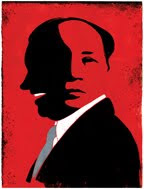I have asked stage director Michael Cavanagh to share with all of us his thoughts on conceiving this new production with set designer Erhard Rom. His (slightly edited) comments follow:
“The journey of Richard Nixon … and other US officials to Communist China in 1972 was one of exploration and exhaustion. Nixon himself said he felt like a voyager of a bygone era, or one of the astronauts who had recently landed on the moon. The gulf between the two cultures was vast, as was the task of gaining any kind of rapport or understanding. Although the trip did open some doors, the consensus was that the main accomplishment of Nixon’s week … was to illustrate the enormity of these challenges. Some were overwhelmed by it all, but at the same time bonds were forged, especially between Nixon and … Chou En-Lai. In the midst of the confusion a way forward emerged.
.JPG)
John Adams’s opera illuminates this historic venture beautifully. The piece parallels the trip in the sense that it starts out full of promise but, in the end, the pace of events and the enormity of the situation take their toll. The scenes begin quite naturalistically but their connection to reality soon starts to go awry. For example, the airfield scene that begins the opera closely follows factual events, but at a certain point there is a shift and it becomes more about Nixon’s disjointed thoughts and impressions. The formal banquet that ends the first act, too, veers into abstract pandemonium. As the opera progresses this distortion effect increases. The final scenes are highly stylized and interpretive. By the end of the opera we are nowhere, really, except inside the characters’ heads.

Our production will reinforce these themes: how vast the gulf between two cultures can be, how some people can find a connection across any such gulf, and how a challenge so overwhelming can distort reality for others. The production will balance the American point of view with the Chinese one, creating a visual world where neither can truly dominate (as much as they try).
The remarkable similarity of one culture to the other in the midst of this seemingly insurmountable gulf will also become apparent through the juxtaposition of powerful images.
We will make consistent use of forced perspective in the building and painting of the set elements as well as with projected images (and) … will be treated to long views of the Ming Tombs, the Forbidden City, the banquet hall, and so on. This will reiterate the vastness of Chinese geography, history and culture. The production will appear quite orderly and realistic at the outset, and slowly, relentlessly deconstruct. The final scene is messy and chaotic at first, featuring various set and prop elements scattered randomly around the stage. The characters wander a landscape littered with the opera’s detritus, trying to make sense of it all. Soon iconic images of the main players emerge into focus, cementing for us their place in history.
The opera will also be filmed in progress. Nixon’s trip was one of the first televised global events … and we will show that happening. A 70’s-era TV/film crew will be seen following the characters around and shooting portions of selected scenes. The captured video will be replayed in the last act. In other words, the audience will see what the “film crew” has shot that very evening, as opposed to something pre-recorded or archival. This will reinforce the immediacy of these historic events, and how powerfully they have affected the emotions and opinions of private citizens and public figures ever since.”
Next week I will share with you information about the people who are thinking through this project and turning it into reality: the design team.
~ James W. Wright, General Director

0 Response to "Behind the Scenes: Production"